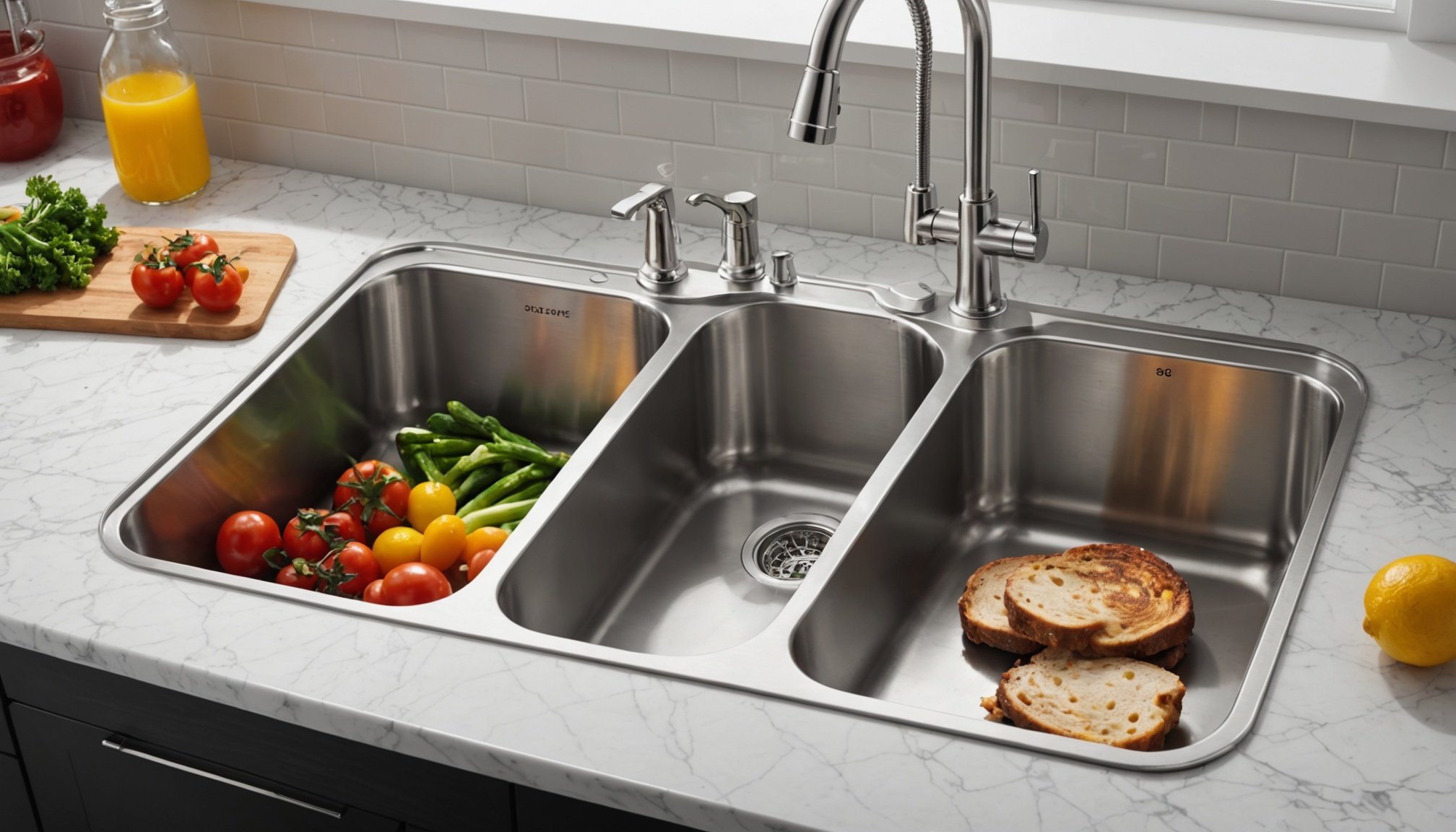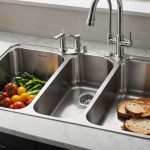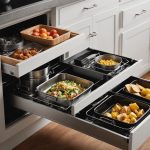A carefully chosen sink can transform your lean kitchen into a more efficient space. It not only streamlines meal cleanup but also helps minimize temptations that lead to clutter. The right design and features can enhance functionality, making everyday tasks simpler. Discover how to select a sink that suits your cooking style while promoting a tidy, focused kitchen atmosphere. Embrace minimalism and make meal preparation a joy rather than a chore.
Importance of Choosing the Right Sink
When it comes to kitchen efficiency, selecting the right sink plays a crucial role. A well-chosen sink can streamline your kitchen workflow, making meal preparation and cleanup faster and more enjoyable.
This might interest you : Discover Ideal Kitchen Island Dimensions for Healthy Meal Prep Success
Consider the impact of sink choice on your daily routine. A sink that is too small can lead to clutter, making it difficult to manage dishes and utensils while preparing meals. Conversely, a larger sink can accommodate more items, reducing the need for constant tidying. This choice directly influences how efficiently you can move through tasks, from washing vegetables to soaking pots and pans.
Sink Design and Meal Preparation
The design of your sink affects how you organize your kitchen space. For instance, a double-basin sink allows for multitasking, such as rinsing vegetables in one basin while soaking dishes in the other. This setup enhances kitchen efficiency by allowing simultaneous tasks, which is particularly beneficial during busy meal times.
Additional reading : Discover the Perfect Kitchen Stool: Key Ergonomic Features for Enhanced Posture and Improved Digestion
- Double-basin: Ideal for multitasking
- Single-basin: Offers more space for larger items
- Integrated drainboard: Helps with drying and organizing
Influence of Sink Size on Clutter Reduction
A thoughtfully sized sink can significantly reduce clutter. By accommodating larger pots and pans, it minimizes the need for additional countertop space, keeping your kitchen organized and efficient. Thus, choosing the right sink size is essential for maintaining a tidy and functional kitchen environment.
Sink Sizing and Space Utilization
Optimizing your kitchen space with the right sink dimensions is key.
Standard Sink Sizes for Small Kitchens
Small kitchen design requires careful consideration of sink dimensions to maximize space. The standard sizes range from 24 to 30 inches wide, which fit comfortably in compact areas. Choosing a sink within these dimensions ensures functionality without overwhelming the space.
Measuring Your Kitchen Space for Optimal Fit
Accurate measurements are crucial when selecting a sink. Start by measuring the cabinet space where the sink will be installed. Ensure there is enough room for the sink and any additional features like an integrated drainboard. This step is essential in achieving a seamless fit that complements your kitchen's layout.
Creative Storage Solutions Around the Sink Area
In a small kitchen design, every inch counts. Implementing space-saving solutions around the sink can greatly enhance efficiency. Consider installing pull-out trays or hanging racks near the sink area. These additions provide extra storage without cluttering the countertop.
- Pull-out trays: Maximize under-sink storage
- Hanging racks: Utilize vertical space
- Corner shelves: Efficiently use corner areas
Focusing on the right sink dimensions and creative storage can transform a cramped kitchen into a more functional and organized space.
Sink Styles and Their Benefits
Exploring various sink styles can significantly enhance both the functionality and aesthetics of your kitchen. Each style offers unique advantages tailored to different needs and preferences.
Popular Sink Styles for Lean Kitchens
Farmhouse sinks are renowned for their large, deep basins, making them ideal for handling oversized pots and pans. They add a rustic charm, seamlessly blending with traditional and modern kitchen designs. Conversely, undermount sinks provide a sleek, minimalist look. Installed beneath the countertop, they allow for easy cleaning and unobstructed counter space.
Advantages of Undermount vs. Drop-In Sinks
The choice between undermount sinks and drop-in sinks often depends on usability and style preference. Undermount sinks offer a seamless appearance, making countertop cleanup a breeze. They are perfect for contemporary kitchens seeking a clutter-free look. Drop-in sinks, however, are easier to install and replace, offering a budget-friendly option without compromising on functionality.
Choosing a Style That Complements Kitchen Aesthetics
Selecting a sink style that aligns with your kitchen's overall design is crucial. Consider the materials and finishes that best match your cabinetry and countertops. A well-chosen sink can serve as a focal point, enhancing the kitchen's visual appeal while maintaining practicality.
- Farmhouse sinks: Rustic charm, deep basins
- Undermount sinks: Sleek, seamless, easy to clean
- Drop-in sinks: Cost-effective, versatile installation
Choosing the right sink styles can transform your kitchen, making it both beautiful and efficient.
Material Selection for Durability and Maintenance
Choosing the right sink material is crucial for longevity and ease of care.
Comparison of Sink Materials
Selecting the appropriate sink materials is essential for balancing aesthetics with durability. Stainless steel sinks are popular due to their resistance to rust and stains, making them an ideal choice for busy kitchens. Composite sinks, made from a blend of materials, offer a variety of colors and finishes, providing a stylish yet durable option. Porcelain sinks, though elegant, may require more careful maintenance to avoid chipping.
Maintenance Tips for Different Sink Materials
Understanding the maintenance requirements of each material can prolong the life of your sink. Stainless steel sinks benefit from regular cleaning with non-abrasive cleaners to maintain their shine. Composite sinks require gentle cleaning agents to prevent surface damage. Porcelain sinks should be cleaned with soft cloths to avoid scratches.
Long-term Durability Considerations
For small kitchens, considering the long-term durability of sink materials is vital. Stainless steel offers unmatched resilience for high-traffic areas. In contrast, composite sinks provide a balance of durability and aesthetic appeal, suitable for those looking to add a touch of style without sacrificing functionality.
- Stainless steel sinks: Rust-resistant, easy maintenance
- Composite sinks: Stylish, durable
- Porcelain sinks: Elegant, requires careful handling
Choosing the right material ensures your sink remains a functional and attractive centerpiece in your kitchen.
Features to Enhance Cleaning Efficiency
Optimizing your kitchen with advanced sink features can make cleaning tasks more manageable.
Benefits of Pull-Down Faucets
Incorporating pull-down faucets into your kitchen setup significantly improves cleaning efficiency. These faucets offer flexible movement, allowing you to direct water flow precisely where needed. This feature is particularly useful for rinsing large pots and pans, ensuring every corner is reached without hassle.
Importance of Integrated Features
Modern sinks often come with integrated features like cutting boards and drying racks. An integrated cutting board provides a convenient space for food preparation, reducing the need for additional countertop space. Similarly, built-in drying racks streamline dishwashing by offering a dedicated area for drying utensils and dishes.
Evaluating Sink Depth and Shape
Choosing the right sink depth and shape is crucial for effective cleaning. A deeper sink allows for soaking and washing larger items without splashing, while a well-designed shape facilitates easy maneuvering of dishes. Consider the following benefits:
- Deep sinks: Ideal for soaking large items
- Wide basins: Provide ample space for cleaning
- Rounded corners: Easier to clean and maintain
Evaluating these features ensures that your sink not only complements your kitchen aesthetically but also enhances its functionality, making everyday tasks more efficient.
Kitchen Layout Considerations
Designing a kitchen layout that promotes efficiency is essential for a smooth workflow.
Optimizing Workflow Through Layout
A well-planned kitchen layout is crucial for optimizing workflow. The placement of the sink plays a pivotal role in this. Ideally, the sink should be positioned between the cooking and prep areas to minimize movement and enhance efficiency. This strategic positioning allows for easy access to both the stove and the countertop, making meal preparation seamless.
- Sink placement: Central to cooking and prep
- Efficient workflow: Reduces unnecessary steps
- Strategic design: Enhances kitchen functionality
Designing for Efficiency
When designing your kitchen, consider how lighting and color schemes can impact your workflow. Proper lighting reduces eye strain and helps you focus on tasks, while a well-chosen color scheme can minimize distractions and create a calming environment. This thoughtful combination of elements contributes to a more efficient and enjoyable kitchen experience.
Practical Tips for Layout Design
- Lighting: Use task lighting above the sink and prep areas
- Color schemes: Opt for neutral tones to maintain focus
- Flow: Arrange appliances to support a natural workflow
By focusing on these design tips, you can create a kitchen that not only looks great but also supports an efficient and productive workflow.
Product Recommendations and User Testimonials
Explore top sink options and real user experiences to make informed decisions.
Top Sink Options for Small Kitchens
Choosing the right sink is crucial for optimizing space in small kitchens. Top recommendations include compact yet functional designs that blend seamlessly into any kitchen layout. The Blanco Precis offers a sleek, modern look with its granite composite material, known for durability and stain resistance. For those seeking a more traditional style, the Kraus Standart PRO provides a robust stainless steel option with soundproofing features, ideal for reducing noise in busy households.
User Testimonials on Sink Performance
User reviews highlight the practicality and efficiency of these sink options. One satisfied customer noted, "The Kraus Standart PRO transformed my kitchen workflow with its spacious design and easy maintenance." Another user praised the Blanco Precis for its "elegant appearance and resilience against daily wear and tear."
Visual Examples in Real Kitchen Settings
Visualizing how these sinks fit into real kitchens can aid decision-making. Consider these scenarios:
- Blanco Precis: Perfect for modern, minimalist kitchens
- Kraus Standart PRO: Complements traditional and contemporary styles
- Ruvati Verona: Ideal for maximizing counter space with its integrated workstation
By exploring these sink recommendations and user experiences, you can find the perfect addition to enhance both the functionality and aesthetics of your kitchen.













